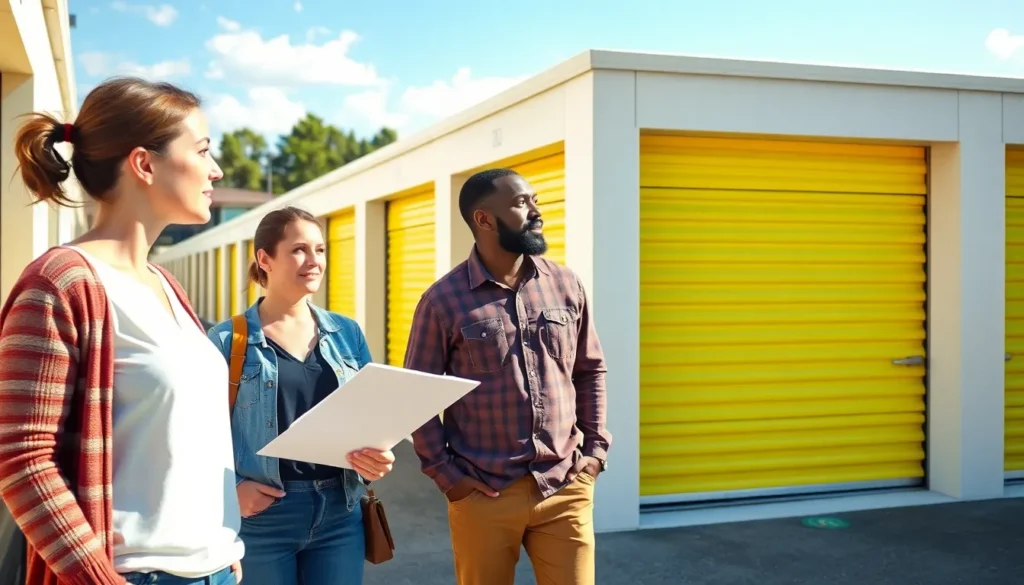Table of Contents
ToggleFinding the right storage unit can feel overwhelming, especially when it comes to pricing. With so many options available, understanding local rates is crucial for making an informed decision. Whether someone is downsizing, moving, or simply looking to declutter, knowing what to expect in terms of cost can save both time and money.
Storage unit pricing varies significantly based on location, size, and amenities. By exploring nearby facilities, individuals can discover competitive rates that fit their budgets. It’s essential to consider not just the price but also the value offered, including security features and accessibility. With the right information, anyone can make a savvy choice for their storage needs.
Understanding Storage Unit Pricing Near Me
Storage unit pricing varies significantly based on several factors unique to each location. Understanding these elements aids individuals in making informed storage decisions.
Factors Influencing Pricing
- Location: Storage unit prices increase in urban areas due to higher demand. Metropolitan regions often feature higher operational costs, resulting in increased rental fees.
- Unit Size: Larger units generally cost more. Standard sizes include 5×5 feet, 10×10 feet, and larger, each priced according to dimensions and capacity.
- Amenities: Facilities offering climate control, security features, and 24/7 access may charge higher rates. These amenities enhance the protection and accessibility of stored items.
- Lease Terms: Month-to-month leases typically incur higher rates compared to long-term contracts. Commitments can lead to discounts or lower monthly fees.
- Demand and Seasonality: Prices fluctuate based on seasonal demand, especially during peak moving seasons. Higher demand can prompt storage facilities to raise prices temporarily.
Types of Storage Units
- Standard Storage Units: Basic storage units are typically available in various sizes and lack climate control, suitable for non-sensitive items.
- Climate-Controlled Units: These units maintain consistent temperature and humidity levels, ideal for sensitive items like electronics, artwork, or antiques.
- Drive-Up Units: Drive-up access allows users to load and unload items directly from their vehicles. This convenience often translates to slightly lower pricing.
- Outdoor Storage: Outdoor units provide options for storing vehicles, boats, or RVs. Pricing is influenced by available space and demand.
- Business Storage Units: Designed for commercial use, these units accommodate inventory, equipment, and documents, often featuring enhanced security and accessibility.
Comparing Prices Across Different Providers

Understanding pricing differences among storage providers helps individuals choose the most cost-effective option for their needs. Various providers, both local and national, offer distinct pricing structures influenced by regional factors and service offerings.
Local Storage Facilities
Local storage facilities often provide competitive pricing tailored to community needs. Prices range from $50 to $300 per month, depending on location and unit size. Many local providers offer promotional deals for new customers, including discounts for the first month. Customers should consider additional factors such as accessibility and security features, which can vary significantly among local options. For example, a facility that provides gated access and video surveillance may command higher rates than one without those features.
National Chains
National chains typically offer standardized pricing and services across multiple locations. Prices usually start around $75 per month and can exceed $500 for larger specialized units. National providers often feature online reservation systems, consistent service quality, and added amenities like climate control. Customers might find adjusted rates due to seasonal promotions or local market demand, which could create opportunities for savings. Comparing prices directly on the providers’ websites helps individuals identify the best deals and available features.
Seasonal Price Fluctuations
Storage unit prices fluctuate seasonally due to varying demand levels throughout the year. Understanding these trends can help individuals make better decisions regarding their storage needs.
High Demand Seasons
High demand seasons typically include warmer months, particularly May through September. During this period, many people move for jobs, school, or family reasons, leading to increased demand for storage units. Pricing rises as facilities capitalize on the influx of customers. Customers seeking storage during these months may encounter higher rates, especially in urban areas where space is limited.
Off-Peak Pricing
Off-peak pricing generally occurs from late fall to early spring, specifically from October to April. Demand decreases during this time as fewer people move or seek storage solutions. Facilities often respond by lowering prices or offering promotions to attract customers. Renting a storage unit during these months can result in significant savings, with prices sometimes dropping by 20% or more compared to peak seasons. Additionally, customers may benefit from better availability and increased flexibility with lease terms during off-peak times.
Additional Costs and Fees
Understanding additional costs and fees associated with storage units is crucial for budgeting effectively. These expenses can impact the overall cost beyond the standard rental price.
Insurance and Security Deposits
Insurance for storage units protects personal belongings against damage or theft. Many facilities require renters to purchase insurance, which can range from $10 to $30 per month, depending on the coverage amount. Some facilities may offer their own insurance plans, while others allow customers to use existing homeowners’ or renters’ insurance. Security deposits are another consideration; they often equal one month’s rent and may be refundable at the end of the rental agreement, contingent upon the unit’s condition.
Accessories and Supplies
Many storage facilities offer accessories and supplies that can add to the costs. Common items include boxes, packing tape, and locks. Prices for supplies can vary significantly, with boxes ranging from $1 to $5 each, depending on size and quality. Purchasing a sturdy lock can cost between $10 and $30. Investing in premium packing supplies may protect items better during storage but will increase overall expenses. Customers should evaluate their needs to determine which supplies are essential.
Finding the right storage unit at a competitive price involves careful consideration of various factors. By understanding local pricing dynamics and evaluating specific needs, individuals can secure a unit that not only fits their budget but also meets their storage requirements.
Exploring nearby facilities can reveal promotional deals and unique features that enhance value. Keeping an eye on seasonal trends can lead to significant savings, especially during off-peak times. Ultimately, making an informed choice about storage involves balancing cost with vital aspects like security and accessibility. With the right approach, anyone can find an ideal storage solution that aligns with their needs and financial plans.




